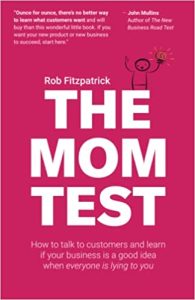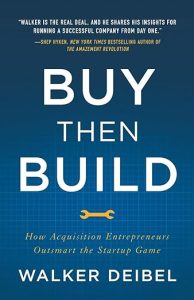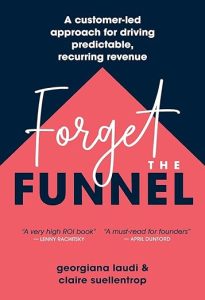I strongly recommend the Mom Test for anyone working on building or improving a product.
The book does a great job of showing common pitfalls product owners make when trying to figure out what to build next. The framework itself is straightforward, with some highly actionable tips/guidance.
The following is a summary of my most significant insights.
“These conversations take time, are easy to screw up and go wrong in a nefarious way. Bad customer conversations aren’t just useless. Worse, they convince you that you’re on the right path. They give you a false positive that causes you to over-invest your cash, your time, and your team.”
pg. 38
The Mom Test
- Talk about your customer’s life instead of your idea
- Ask about specifics in the past instead of opinions about the future
- Talk less and listen more
Asking questions about someone’s experiences is the best way to learn their pain points and how they have tried to solve them. The future is unknown, and everyone tends to be overly optimistic. You know you pass the mom test if you aren’t talking specifically about your idea and looking for validation and compliments.
People say you shouldn’t ask your mom whether your business is a good idea. That’s technically true, but it misses the point. You shouldn’t ask anyone whether your business is a good idea. At least not in those words. Your mom will lie to you the most (just ‘cuz she loves you), but it’s a bad question and invites everyone to lie to you at least a little.
pg. 1
Getting Back On Track
We naturally tend to pitch our idea when having customer interviews. It’s going to happen, so how do we get back on track?
- Deflect compliments
- Anchor fluff
- Dig beneath opinions, ideas, requests, and emotions
“It boils down to this: you aren’t allowed to tell them what their problem is, and in return, they aren’t allowed to tell you what to build. They own the problem, you own the solution.
pg. 16
When someone starts talking about what they “always” or “usually” or “never” or “would” do, they are giving you generic and hypothetical fluff. Ask good questions that obey The Mom Test to anchor them back to specifics in the past. Ask when it last happened or for them to talk you through it. Ask how they solved it and what else they tried.”
Mistakes To Avoid
- Fishing for compliments – “I’m thinking of starting a company to solve XYZ problem, what do you think?”
- Exposing your ego, aka the Pathos Problem
- Being sales focused or pitching too much
- Being too formal
- Being a learning bottleneck (not preparing or writing down notes from customer interviews)
- Collecting compliments instead of factors and commitments
Best way to avoid these mistakes? Plan ahead.
Pre-plan the 3 most important things you want to learn from any given type of person (e.g. customers, investors, industry experts, key hires, etc). Update the list as your questions change. Pre-planning your big questions makes it a lot easier to ask questions which pass The Mom Test and aren’t biasing.
pg. 55
Don’t Be A Bottleneck
When all the customer learning is stuck in someone’s head instead of being disseminated to the rest of the team, you’ve got a learning bottleneck. Avoid creating (or being) the bottleneck. To do that, the learning must be shared with the entire founding team promptly and faithfully, which depends on good notes plus a bit of pre- and post-meeting work. The most extreme way to bottleneck is to go to the meetings alone and take crappy notes which you don’t review with your team. At that point, your head has become the ultimate repository of customer truth and everyone just has to do what you say.
The Mom Test Process
- Create a focused segment (get prescriptive on who you are selling to)
- With your team – decide on the big 3 learning goals from the customer interview
- Be clear on ideal next steps and commitments
- If questions can be answered at your desk, do that first
- Frame the conversion
- Keep it casual
- Ask good questions which pass the mom test
- Deflect compliements
- Take good notes
- Review your notes
- Transfer notes to permanent storage
- Update your beliefs and plans
- Decide on the next 3 big questions
- Repeat
The questions to ask are about your customers’ lives: their problems, cares, constraints, and goals. You humbly and honestly gather as much information about them as you can and then take your own visionary leap to a solution.
pg. 16
Rules Of Thumb
- People know what their problems are, but they don’t know how to solve those problems.
- You’re shooting blind until you understand their goals.
- Some problems don’t matter.
- Watching someone do a task will show you where the problems and inefficiencies are, not where the customer thinks they are.
- If they haven’t looked for ways of solving it already, they’re not going to look for (or buy) yours.
- People stop lying when you ask them for money.
- People want to help you. Give them an excuse to do so.
- Anyone will say your idea is excellent if you’re annoying enough about it.
- The more you talk, the worse you’re doing.
- You should be terrified of at least one of the questions you ask in every conversation.
- There’s more reliable information in a “meh” than in a “Wow!” You can’t build a business on a lukewarm response.
- Start broad, and don’t zoom in until you’ve found a strong signal with your whole business and every conversation.
- You always need a list of your three big questions.
- Learning about a customer and their problems works better as a quick and casual chat than a long, formal meeting.
- Give as little information as possible about your idea while still nudging the discussion in a helpful direction.
- The meeting is pointless if you don’t know what happens next after a product or sales meeting.
- The more they give up, the more seriously you can take what they’re saying.
- It’s not a real lead until you’ve given them a concrete chance to reject you.
- In early-stage sales, the real goal is learning. Revenue is a side-effect.
- Keep having conversations until you stop hearing new stuff.
- If you aren’t finding consistent problems and goals, you don’t have a specific enough customer segment.
- Good customer segments are a who-where pair. If you don’t know where to find your customers, keep slicing your segment into smaller pieces until you do.
- You shouldn’t bother having the conversation if you don’t know what you’re trying to learn.
What Could Have Made This Book Better?
A framework or visual concept to execute the strategy. I realize each business idea will require something different with product interviews. However, it would have been nice to see this in a visual format because I am left feeling like I need to create a template in order to remember the tips/strategies in this book.
Join The Newsletter
Get occasional emails from me when I publish new projects and articles.



